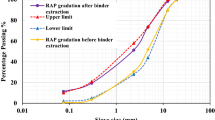Abstract
Stone matrix asphalt mixes are widely used in Western Europe due to its high strength properties in pavements, this type of mix is subjected to continuous wetting and drying cycles due to its porous structure leading to a higher potential for stripping. Lime has long been recognized and used in industry to reduce the stripping potential of SMA. Aggregate grading has also been identified to have an impact on the moisture damage potential. Response surface methodology was employed in this paper to evaluate the effect of lime content and grading on stripping potential of Stone Matrix Asphalt (SMA) using Tensile Strength Ratio (TSR) index. The statistical significances of linear, quadratic and interactive terms of the lime percent and grading were examined and second order polynomial regression equation was successfully fitted to the experimental results. The lime content of 1% and the finest aggregates resulted in a TSR optimum value of 91.8%±0.8%. It was further concluded that increasing the mastic asphalt would decrease the stripping potential of SMA and both of the two parameters evaluated, had approximately the same main effect on the TSR response.
Similar content being viewed by others
References
Abo-Qudais, S. (2007). “The effects of damage evaluation techniques on the prediction of environmental damage in asphalt mixtures.” Journal of Building and Environment, Vol. 42, pp. 288–296.
Brown, E. R. and Cooley, L. A. (1999). Designing stone matrix asphalt mixtures for rut-resistant pavements, NCHRP Reports 425, Transportation Research Board, National Research Council Washington, D.C.
Gorkem, C. and Sengoz, B. (2009). “Predicting stripping and moisture induced damage of asphalt concrete prepared with polymer modified bitumen and hydrated lime.” Journal of Construction and Building Materials, Vol. 23, pp. 2227–2236.
Hicks, R. G. (1991). Moisture damage in asphalt concrete, NCHRP Synthesis of Highway Practice, Transportation Research Board, Vol. 175, Washington, D.C.
Khosla, N. P., Birsdall, B. G., and Kawaguchi, S. (2000). “Evaluation of moisture susceptibility of asphalt mixtures conventional and new methods.” Transportation Research Record 1728, Transportation Research Board, Washington, D.C.
Kiggundu, B. M. and Roberts, F. L. (1998). Stripping in HMA mixtures: State of the art and critical review of test methods, National Center for Asphalt Technology, NCAT Report 88-2.
Kim, S. and Coree, B. J. (2005). Evaluation of hot mix asphalt moisture sensitivity using the Nottingham asphalt test equipment, Department of Civil, Construction and Engineering, Report No. IHRB Project TR-483, Iowa State University.
Lee, S., Seo, Y., and Kim, R. (2010). “Effect of hydrated lime on dynamic modulus of asphalt-aggregate mixtures in the state of North Carolina.” KSCE Journal of Civil Engineering, Vol. 14, No. 6, pp. 829–837.
Little, N. D. A. and Epps, J. (2001). The benefits of hydrated lime in HMA, Prepared for the National Lime Association, National Lime Association (LIME).
Mehrara, A. and Khodaii, A. (2011). “Evaluation of asphalt mixtures moisture sensitivity by dynamic creep test.” Journal of Materials in Civil Engineering (ASCE), Vol. 23, No. 2, pp. 212–219.
Moghadas Nejad, F., Aflaki, E., and Mohammadi, M. A. (2010). “Fatigue behavior of SMA and HMA mixtures.” Journal of Construction and Building Materials, Vol. 24, pp. 1158–1165.
Montgomery, D. C. (2006). Design and analysis of experiments (6th edition), John Wiley & Sons, New York.
Richardson, J. T. G. (1997). Stone mastic asphalt in the Uk symposium on stone mastic asphalt and thin surfacing, London, Richter E.
Serfass, J. P. and Samanous, J. (1996). “Fiber-modified asphalt concrete characteristics, application and behavior.” Journal Association Asphalt Paving Technology, AAPT, Vol. 65, pp. 193–230.
Sivilevicius, H., Podvezko, V., and Vakriniene, S. (2011). “The use of constrained and unconstrained optimization models in grading design of hot mix asphalt mixture.” Journal of Construction and Building Materials, Vol. 25, pp. 115–122.
Sivilevicius, H. and Vislavicius, K. (2008). “Simulation of the influence of variation of mineral material grading and dose weight on the homogeneity of hot-mix asphalt.” Journal of Construction and Building Materials, Vol. 22, pp. 2007–2014.
Stuart, K. D. (1990). Moisture Damage in asphalt mixtures — A state of the art report, FHWARD-90-019, Federal Highway Administration.
Süreyya, T., Halit, O., and Atakan, A. (2007). “Investigation of rutting performance of asphalt mixtures containing polymer modifiers.” Journal of Construction and Building Materials, Vol. 21,No. 2, pp. 328–337.
Author information
Authors and Affiliations
Corresponding author
Rights and permissions
About this article
Cite this article
Khodaii, A., Haghshenas, H.F., Kazemi Tehrani, H. et al. Application of response surface methodology to evaluate stone matrix asphalt stripping potential. KSCE J Civ Eng 17, 117–121 (2013). https://doi.org/10.1007/s12205-013-1698-6
Received:
Accepted:
Published:
Issue Date:
DOI: https://doi.org/10.1007/s12205-013-1698-6




